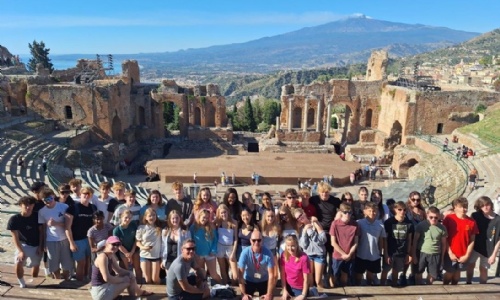Geography Trip to Sicily

Monday 6 October – Giardini Naxos and Letojanni. Around 2.30am, forty bleary-eyed Year 11 students arrived at School, said their goodbyes to parents (who seemed happy to be waving their teenage children off for a week) and boarded the coach for Gatwick Airport. After a particularly bumpy landing (at the second attempt!), we stepped down from the plane to be greeted by palm trees and the warmth of Catania, Sicily. First stop was the Ancient Greek archeological site at Giardini Naxos, the first Greek settlement on Sicily, before lunch and transit to the hotel in Letojanni. After unpacking, we explored the coastline of the village then had an early night, after a long first day.
Tuesday 7 October – Mount Etna, by Ben Alliston and Grace Cullen. On the second day of our trip, we visited a large lava field at the bottom of Mount Etna, where we learnt about how eruptions affected small villages surrounding the volcano and about the volcanic rock. Then we returned back to the coach which took us on a scenic journey to main bottom of Mount Etna, Europe’s largest active volcano, where we the got on the cable cars that took us halfway up the volcano. Once we arrived at this point the temperature began to drop, and the clothing layers started. While enjoying the views from this point and waiting for the other groups to get to us, we noticed how easily it went from being clear and able to see the sea and the Silvestri crater to cloudy and low visibility.
Once all the groups had joined us, we hopped in 4x4 trucks which took us to the next part of the mountain and the final part a vehicle could get up. We started our walk being led by our tour guides finding out at this point we were over 3000m up, with frequent stops to discuss the geology and take in the views around us. The winds were increasing with volcanic ash being blown everywhere and at us, we started our descent back. We then returned by the 4x4s and cable-cars, had lunch, and visited the gift shops. Finally, we travelled back to the hotel and had some free time where we could visit the shop, or go to the beach.
Wednesday 8 October – Vulcano Island, by Lucy Edgar. We left the hotel bright and early at 6:20 in the morning taking an hour and a half coach to Milazzo harbour in order to catch the hydrofoil to the Aeolian Islands. The hydrofoil journey took about an hour to get there where some of us caught up on missed sleep. On arrival to the island, we set off almost straight away to start our ascent up to the crater of Vulcano. The views were amazing from the start to the end of the walk, and the clear blue skies meant we were easily able to see the other islands from the top. Thankfully during the climb on that day, it was very much warmer than Mount Etna. Towards the top, we began to see the sulphur field and definitely could smell it. The higher we walked the windier and cooler it became. Once most of us reached the summit, lots of photos were taken and some of us saw another volcano erupt from a distance. After a good period of time at the summit we began our descent which was much quicker than our ascent. At the bottom, we walked to a Black Sands Beach and had the opportunity to swim and get lunch before boarding the hydrofoil again to return to the hotel.
Thursday 9 October – Taormina and the Alcantara Gorge, by Heidi Paddock. On Thursday 9 October we visited the Graeco-Roman theatre (Teatro Antico de Taormina, in Italian) in Taormina, which has been in constant use for 2500 years. With the capacity to hold an audience of 10,000, it would regularly stage comedies and tragedies but now hosts many music concerts and the annual Taormina film festival. We then explored the theatre which provided breathtaking views of the sea and historic town on both sides of the stage with Mount Etna visible from the audience's perspective. Afterwards, we went sightseeing in the picturesque town of Taormina which was once the largest Roman city in Eastern Sicily, now containing many shops for souvenirs and authentic Italian restaurants for lunch. With its charming streets, lined with character, the town is a popular location for tourism, with the theatre attracting 245,000 visitors each year. We then visited the Alcantara Gorge which over thousands of years and the rapid cooling of lava has sculpted unique, ancient walls made of igneous rock. These nature-carved walls tower over the shaded, icy stream which flows in-between them containing small waterfalls. Students waded up through the magnificent gorge, with some even daring to fully enter the freezing cold water before ending a day of unforgettable sights and spectacular scenery.
Friday 10 October – return to Bourne. The day was spent travelling home. Our flight headed north, passing straight overt the Aeolian Islands that we had visited on the Wednesday. Leaving 25-degree heat, we arrived to grey skies and a mildly respectable 13 degrees in Luton! The group was back at school by 7.30, met by refreshed-looking parents. We headed home, having experienced Physical Geography firsthand. We would like to thank the students for their excellent behaviour and keen interest in the geography of Sicily.
